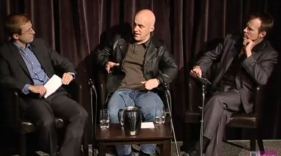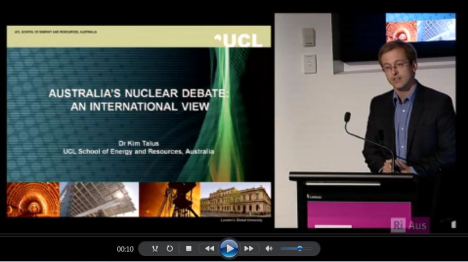 Thinking Critically About Sustainable Energy (TCASE) is a series of posts I’ve built up over the last year on BNC (and continue to add to). This has also branched off into a live seminar series (described in detail in this post), hosted by the Royal Institution of Australia (RiAus), and has proven to be very popular (a packed house each session). So far, we’ve covered new technologies in fossil fuels (including carbon capture and storage), established renewables (e.g. wind, solar), frontier renewables (e.g. engineered geothermal, marine), and, last week, nuclear. In the next session we will cover ‘demand side management and energy storage’ (event #5 on 3 Nov, with guests Craig Oakeshott from AEMO and Glenn Platt from CSIRO), and to cap off the series, energy futures: alternative 2050 visions (event #6 on 8 Dec, with guests Ziggy Switkowski from ANSTO and Peter Seligman from Uni Melbourne). Book your seats for the last two events!
Thinking Critically About Sustainable Energy (TCASE) is a series of posts I’ve built up over the last year on BNC (and continue to add to). This has also branched off into a live seminar series (described in detail in this post), hosted by the Royal Institution of Australia (RiAus), and has proven to be very popular (a packed house each session). So far, we’ve covered new technologies in fossil fuels (including carbon capture and storage), established renewables (e.g. wind, solar), frontier renewables (e.g. engineered geothermal, marine), and, last week, nuclear. In the next session we will cover ‘demand side management and energy storage’ (event #5 on 3 Nov, with guests Craig Oakeshott from AEMO and Glenn Platt from CSIRO), and to cap off the series, energy futures: alternative 2050 visions (event #6 on 8 Dec, with guests Ziggy Switkowski from ANSTO and Peter Seligman from Uni Melbourne). Book your seats for the last two events!
That was just a reminder, however. The main purpose of this post was to highlight the content of TCASE Seminar #4: Interactive discussions about the future of nuclear power, held last Wednesday 8 Oct 2010 at the RiAus. The moderator for this session was Prof Gus Nathan, Director of the Centre for Energy Technology (CET). There were two speakers, Dr Kim Talus from University College London’s School of Energy and Resources, and me (Barry Brook, from University of Adelaide and also a member of the CET). I have to say, I think it was the most enjoyable and worthwhile public event I’ve been engaged with over the last few years. All three speakers/panelists really clicked, the questions and answers (conducted in the style of the gentle art of interrogation) flowed naturally, and the audience was also genuinely engaged.
Now I know people tend to be reluctant to watch videos etc. online, rather than in attendance, but I’d really urge you to take the time and watch this event. It’s something I’m very proud of (and I don’t say this lightly). Moreover, I think it — between my cover talk and the subsequent Q&A sessions — covers most of the major bases of my thinking on nuclear energy as a sustainable energy source and a key solution in the effort to mitigate our current fossil fuel dependence.
In sum there were 3 parts to the event. (click on the images below to download the associated .MOV files).
First, Gus, Kim and I all provide a to-camera introduction to our talks (about 2 minutes each), and then Gus kicks it off with a short context setter (.MP3 audio here):
Next, Kim Talus provides a short talk (13 min long), entitled “Australia’s Nuclear Debate: An International View” (download PPT file here as a PDF). After Kim’s presentation, Gus and I ask Kim some probing questions for about another 12 min (we cover economics, political impediments, what Finland is doing [Kim is Finnish], etc.).
Finally, I give a 17 min talk, “Inexhaustible Fission Energy“. Again, this is followed by a detailed Q&A session amongst the three panelists, which lasts for another 19 min. We cover issues of risk management, international developments and domestic decision making, motivations for opposition to nuclear energy as a climate change solution, and so on.
This panel-driven Q&A sessions were followed up with about 20 min of Q&A with the audience, but I currently don’t have access to the video/audio for this — if I get it, I’ll also post it here. Perhaps those BNC commenters who attended on the night can report on what they thought was important from that final part of the evening.
I hope you find these videos worthwhile. I earnestly believe that we need more public debate on critical 21st century issues like sustainable energy, climate change, good governance etc., but they need to be conducted in formats like this in the future. Nothing beats thoughtful Q&A via ‘gentle interrogation’, as opposed to disconnected polemics that often characterise public ‘debates’. I trust you agree — and if not, tell me why not!






.png)









You need to take this show on the road.
well: Barry, I listened to the talk that ended with the Mahaffey quote.
I just read that book (Atomic Awakening), and I was puzzled by his dismissal (pretty much in a footnote, followed by a disparaging reference to a SuperPhenix salt spill) of Molten Salt reactors: he notes that such reactors “have always been temperamental, unforgiving beasts. At the slightest blockage or interruption of coolant flow, she melts.”
I would be curious to hear your reaction and George Stanford’s. comments like this of course are what give people like Caldicott, talking of fast reactors, credibility.
but in the light of the argonne tests, etc., these comments seem ignorant. diametrically opposed to the article of fast reactors you posted just last month. yet clearly this is a guy with a lifetime in the nuclear industry, who is very pro nuclear (water reactors).
George: do you know James Mahaffey? Don’t you guys talk to one another or is this non communication a function of nuclear secrecy?
barry: the citation above is from note 159 on p. 208.
@ Barry – OK, I downloaded and watched all three videos. I must say I do like the idea of classifying nuclear as “Inexhaustible energy.” We must get everyone to start using this meme to avoid the quibbling that goes on over whether it should be considered a renewable or non-renewable source. Quite brilliant actually, of course fusion can be added to this class as well.
Both of you made good arguments for the adoption of nuclear energy, I’m afraid however you tended to avoid the politics, and that is possibly the single most important factor slowing the adoption of nuclear energy.
It isn’t cost, it never was. Consider the highway networks of the world, that built after WWII, it was clearly understood that this was a form of infrastructure that was required to move economies forward, because it permitted trade in goods and services to a much wider area than even the railroads offered. There was no question that these networks were to be build with public bonds, and paid for over time with the increased tax revenues.
Energy is the new infrastructure, we need more of it if we are going to progress, and if we are going to reverse some of the damage we have done to this planet. And it needs to be clean, and it needs to be inexpensive to produce and deliver, why it is not widely understood that the only technology available that can deliver this is nuclear fission, is the only real question in this debate.
I’m not suggesting that this is the way to go, I’m just pointing out that cost per se would not be an issue if there was a will. It is this lack of will that must be addressed, and while part of it is public fears that have been cultivated by antinuclear propaganda, the other part is governments that are being made to drag their heals by vested interests. Failure to recognize this is one of the single biggest reasons pronuclear forces have been unable to get any traction for the past thirty years.
The game is fixed, and that is part of the message we need to get out. I understand that as an intellectual you abhor polemics, but unfortunately those techniques will be the ones that are used against you, and while they will have no impact on your peers, they will carry the popular mind. I don’t like it anymore that you do, but in a world where a bimbo can talk a significant number of people out of getting their own kids vaccinated ‘gentle interrogation’, just won’t cut it.
@greg meyerson – People are going to be pushing the designs they are stakeholders in. This will often include dumping on other competitors when they have a chance. That’s just business.
One of the critical questions Barry posed is:
“Can we disentangle nuclear weapons from nuclear power generation?”
Even though nuclear power is inevitable in the long run it can be delayed by decades if we fail to educate the general public.
@greg, most nuclear engineers remain unaware of the existence or importance of the Argonne tests or the IFR programme in general. Mahaffey is a water-moderated man, and his book reflects this inclination!
@DV8 – thanks for the feedback. I mostly agree. When I said ” as opposed to disconnected polemics that often characterise public ‘debates’” I really meant when you have a pro- and anti-nuclear person having a public ‘debate’. This gets nowhere.
I’d much prefer more ‘positivistic’ nuclear information sessions, where we dispense with the Caldicott/Diesendorfs and simply discuss the issues and promote the benefits of, and critical need for, fission power. It’s similar to climate change ‘debates’ – why do we always need the ‘balancing’ sceptic? Answer is, we don’t.
I attended the seminar the other night, and I have to agree, it did beat the often fruitless back and forthing of the traditional debating format. It allowed for the seminar and questioning to delve to a much deeper level of discussion than usual, despite seminar events always being time-limited and thus-content limited.
I can’t recall anything of particular importance coming up during the Q&A with the audience at the end, though I did note that there didn’t seem to be any anti-nuclear sentiments from the audience, or if there was they kept very quiet.
Another thing I have noted from the TCASE seminars so far is that most of the audience are middle aged or older – not many young people there. Just an observation, but it seems a shame. I assume they’re either not interested or the word’s just not getting out there enough.
Overall, it was a great seminar.
DV8 said:
Interesting take. I wonder what Peter Lang makes of this.
OT – Bolt discusses news about the cost of solar subsidies in Spain. Not to mention the regime risk associated with investors banking on subsidies:-
http://blogs.news.com.au/heraldsun/andrewbolt/index.php/heraldsun/comments/spain_fried_by_solar_power/
[…] and Saturday (ABC News 24 at 1pm for an extended 1 hour version). It’s based around my TCASE series run with the RiAus — specifically, the sustainable nuclear power event. You can watch a 7 min preview clip here […]